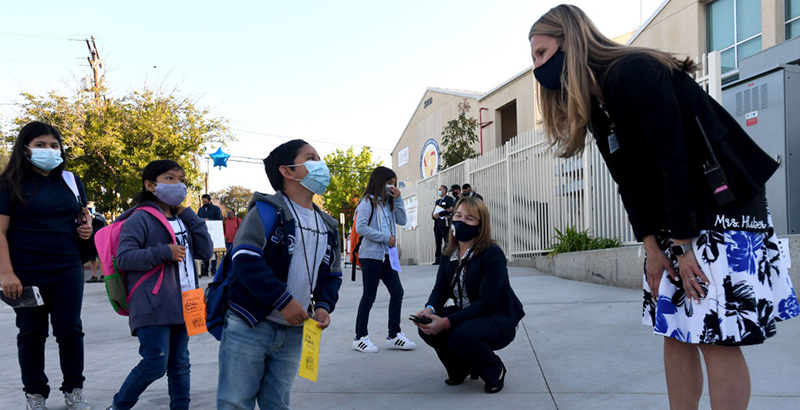Educators’ View: Principals Know Best What Their Schools Need. They Should Have a Central Role in Deciding How Relief Funds Are Spent

The recent passage of the American Rescue Plan represents a once-in-a-generation federal commitment to K-12 schools across the country. The impact will be felt immediately: The $122 billion in direct funding will support safe school reopenings and help ensure that those schools already providing in-person instruction can safely stay open. Beyond reopenings, the funds will be critical to helping students recover from academic and mental health challenges induced and exacerbated by the pandemic.
How these funds are distributed will shape the educational prospects of millions of students, affecting the country for decades to come. As they make rescue plan funding decisions, states and districts should meaningfully engage and empower school principals throughout all phases of implementation. Principals, as leaders of their school buildings and staff, have unequaled insights into their individual schools’ needs and know which resources are needed most urgently.
Avoid one-size-fits-all solutions: Directly engage principals about their school-level needs
Each school is unique; thus, each school’s needs are unique. As school leaders continue to navigate difficult day-to-day decisions on everything from staffing to resources for learning recovery to adherence to public health guidelines, states and districts must understand how these needs vary from school to school. Establishing a feedback loop is a win-win: It gives principals an opportunity to communicate their needs while ensuring that resources are used effectively to meet the needs of students, families and educators.
Position principals as instructional leaders to help lead academic recovery efforts
The pandemic has exacerbated already-yawning achievement gaps, making the challenge of helping students recover academically even more difficult. Decisions on how to make up for lost learning — such as whether to provide high-intensity tutoring and summer enrichment programs — have considerable academic, social and moral implications. Principals are eager to take on this tremendous challenge, but they need robust support and clear autonomy. As states and districts confront uncharted waters, they can employ a proven, high-impact strategy to strengthen student learning: position principals as instructional leaders, which is critical to improving teaching and has been shown to raise student achievement by two to seven months of learning in one school year. The success of academic recovery interventions hinge on the extent to which principals believe in the effectiveness of these strategies, have a hand in shaping them and feel empowered to carry them out.
Leverage principals to address student mental health challenges
Beyond the severe impact on academic achievement, the pandemic has caused trauma and increased mental health challenges for students. Being physically out of school for months has upended students’ support systems, creating isolation and making it difficult for school-based mental health professionals to reach students. As the relief funds are deployed to address student mental health needs, consideration should be given to how school leaders can implement schoolwide strategies that facilitate multi-tiered system of supports. These strategies could include improving staffing ratios between school psychologists/counselors and students and boosting sensitivity training to help school staff better understand trauma’s impact on students and how they can help them heal.
Maximize principals’ relationships with parents, families, and community members
According to the Pew Research Center, Americans trust K-12 principals more than other authority figures to be caring, to provide fair and accurate information and to handle resources responsibly. This trust and goodwill will be extremely valuable in the coming months. Principals, and the relationships they have developed with students and families, will be key to effectively communicating with these stakeholders throughout the relief plan’s implementation. As more schools reopen and the contours of the pandemic evolve, new challenges will arise and setbacks will occur. Principals can help navigate these choppy waters. The coronavirus pandemic has forever changed the principalship, but a principal’s role as the nexus of stakeholders in the K-12 ecosystem has endured.
There is no doubt that the challenges schools will face in the coming months are immense and almost overwhelming: reopening buildings and keeping them open, ensuring student and staff safety, and addressing an avalanche of academic and mental health needs. With the American Relief Plan, the Biden administration and Congress have taken a bold step to help schools confront these challenges head on and emerge even stronger. We believe principals must play a central role in these efforts. We have never been prouder to represent the nation’s school principals, who are hard at work helping students, educators and families overcome this tumultuous period and not just return to normal, but chart a new course for K-12 education.
Dr. L. Earl Franks is executive director of the National Association of Elementary School Principals, with over three decades of pre-K-12 education experience. Ronn Nozoe is chief executive officer of the National Association of Secondary School Principals and a former deputy state superintendent, district superintendent, principal, vice principal and teacher in his home state of Hawaii.
Help fund stories like this. Donate now!

;)